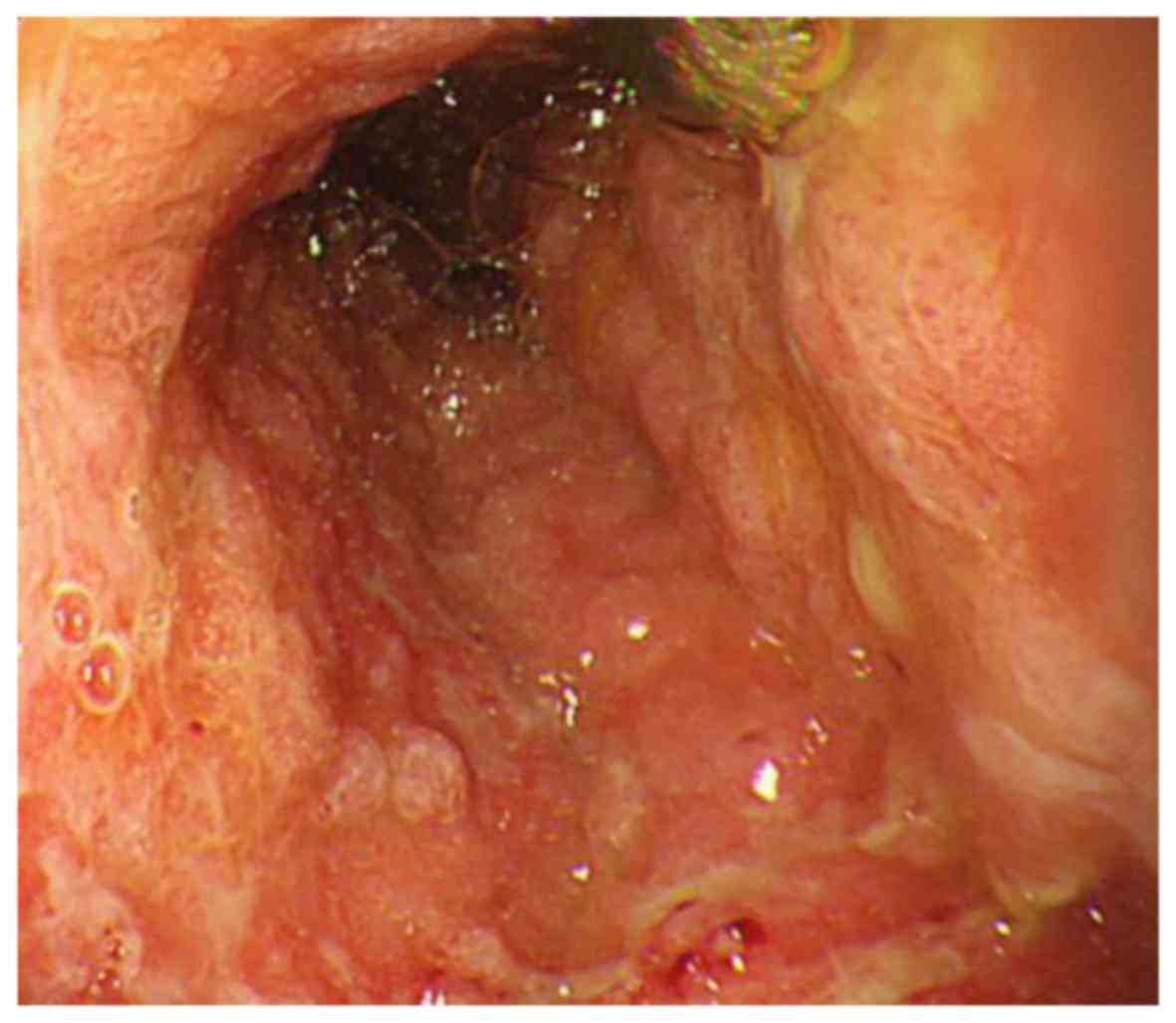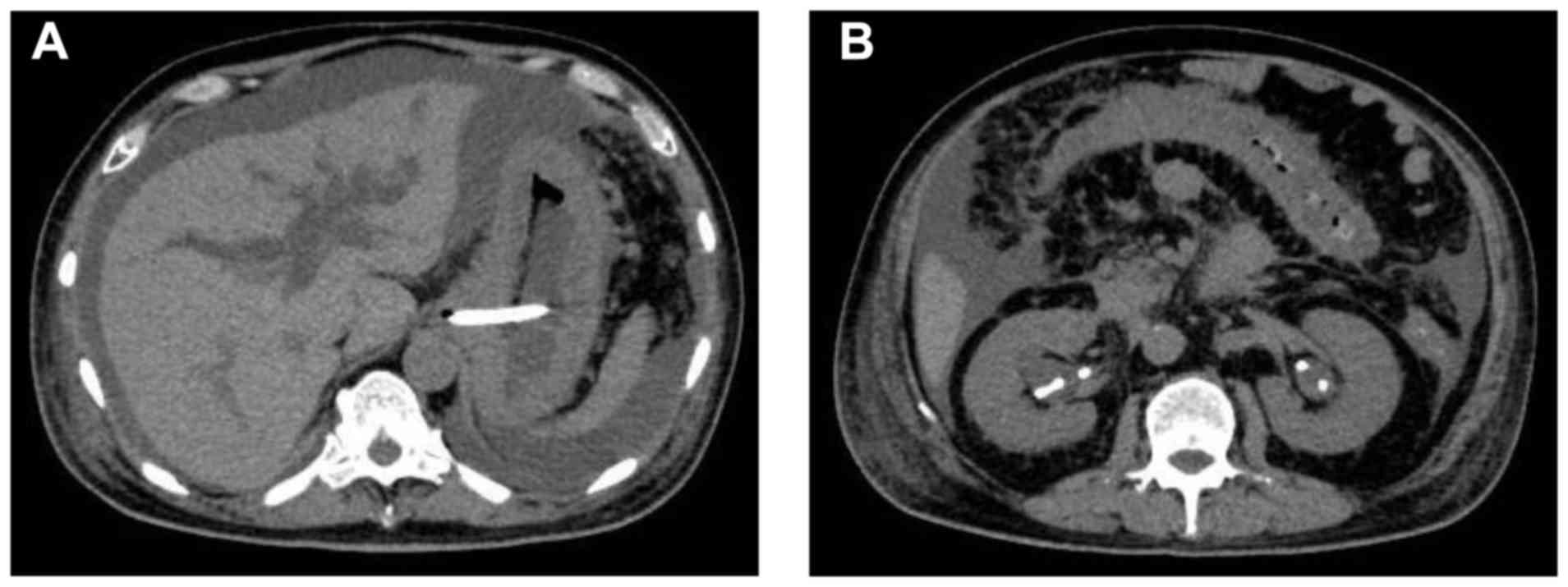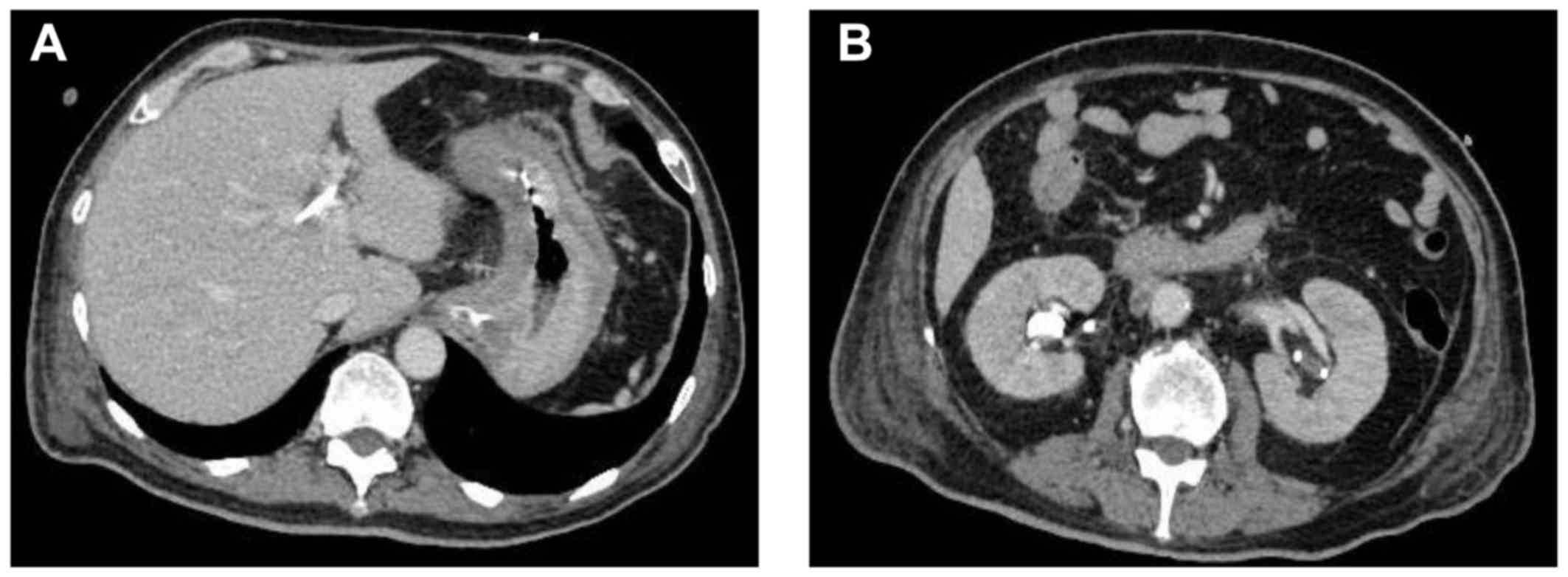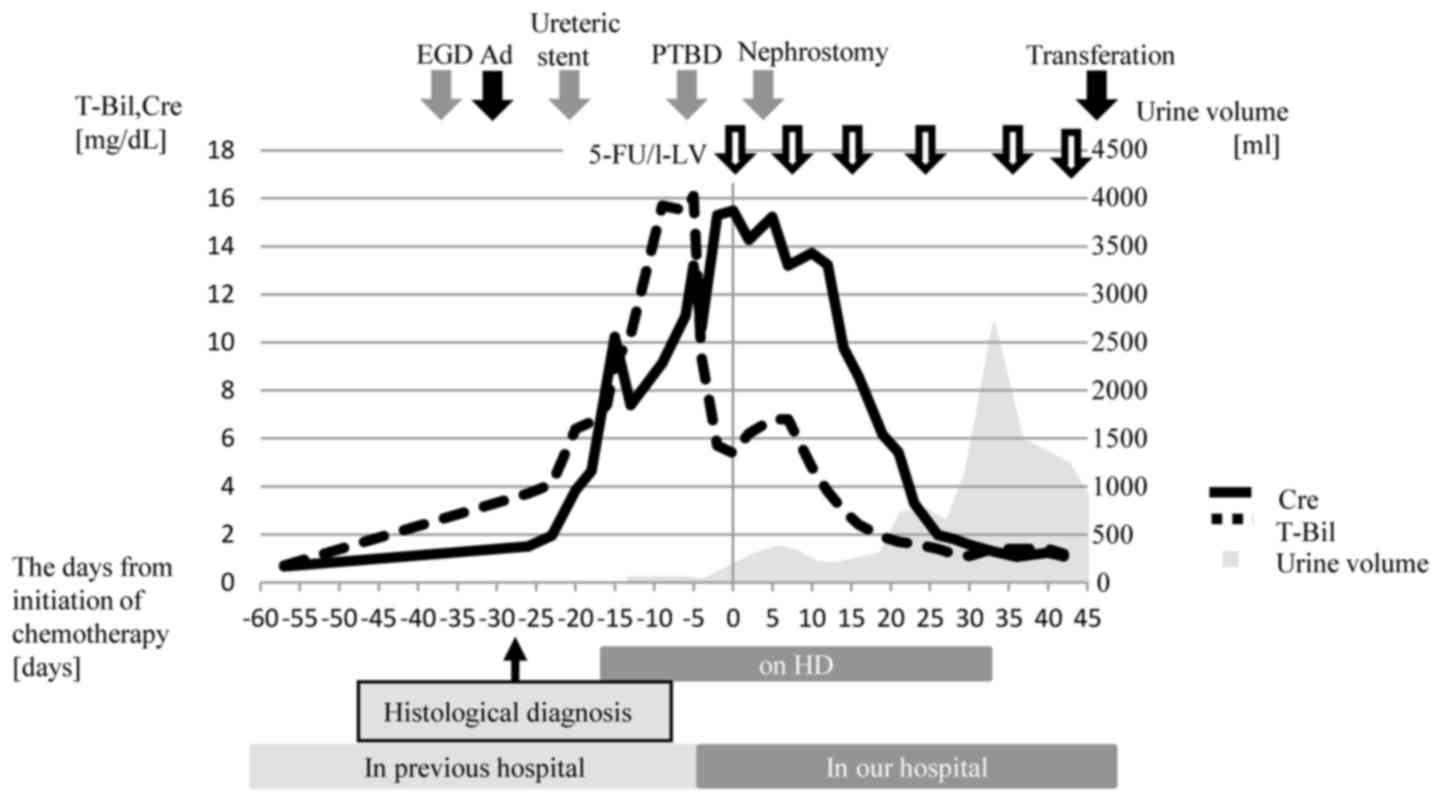Early administration of systemic chemotherapy should be considered for scirrhous gastric cancer: A case report
- Authors:
- Published online on: November 16, 2018 https://doi.org/10.3892/mco.2018.1767
- Pages: 113-117
Abstract
Introduction
Gastric cancer is a common malignant disease with high incidence and mortality rates worldwide (1). Scirrhous gastric cancer accounts for 10 20% of all gastric cancers and is characterized by an abundant stroma in comparison with medullary carcinomas, which are characterized by scant stroma (2). Despite recent advances in the diagnosis and treatment of gastric cancer, the prognosis of the affected population remains poor. The clinicopathological characteristics of this population include poorly differentiated and diffusely infiltrating tumor cells that disseminate to the peritoneum and retroperitoneum, where they induce fibrosis (3,4). This type of dissemination accompanied by fibrosis frequently causes bowel obstruction, obstructive jaundice, and retroperitoneal fibrosis (RPF), which lead to ureteral obstruction and renal failure (5). Organ dysfunction progresses and the performance status of patients in this population worsens rapidly because of the rapid progression of this cancer; it then becomes difficult to administer chemotherapy, and thus these patients have a poor prognosis (6,7). Therefore, earlier diagnosis and treatment may be especially important for this population. Although it appears that the clinical course of scirrhous gastric cancer is not well understood by general physicians; despite the lack of clear evidence and reports on systemic chemotherapy in these patients, experienced gastrointestinal oncologists, who are already experienced can share information about the effectiveness of the early administration of systemic chemotherapy in these cases. Experienced oncologists seldom hesitate to initiate systemic chemotherapy before disease progression in these patients.
Here, we report a patient who suffered from organ dysfunction, including acute renal dysfunction with RPF due to scirrhous gastric cancer, and who previously underwent hemodialysis (HD). During the time the patient underwent HD, 5-fluorouracil/l leucovorin (5-FU/l LV) was administered and was efficacious; this contributed to his withdrawal from HD and an improvement in his performance status, despite his poor condition. We suggest that it will be better for physicians to consider the administration of systemic chemotherapy before supportive HD was introduced and before his general condition worsened.
Case report
A 68-year-old Japanese male who was diagnosed with scirrhous gastric cancer with peritoneal and retroperitoneal dissemination was referred to our hospital for further treatment. His medical history was unremarkable. Scirrhous gastric cancer was identified by esophagogastroduodenoscopy as shown in Fig. 1. The histological diagnosis was poorly differentiated adenocarcinoma, which was HER2 negative by immunohistochemistry. Abdominal computed tomography (CT) showed gastric wall thickening, moderate ascites, bilateral hydronephrosis, and intrahepatic bile duct dilatation (Fig. 2). When he was previously treated at another hospital, the renal and hepatic function were initially normal but were elevated as time progressed; he then became anuric and exhibited obstructive jaundice. He became anuric after stenting for ureteral obstruction, and thus HD was initiated. Furthermore, he was unable to receive food or medication orally because of bowel obstruction by peritoneal metastasis. He was then transferred to our hospital, and the laboratory data obtained upon admission are listed in Table I. The serum creatinine and total bilirubin levels were high at 11.1 and 15.5 mg/dl, respectively. In Keio University Hospital (Tokyo, Japan), we performed percutaneous transhepatic biliary drainage, and consequently, the patient's jaundice improved gradually. Although his performance status was poor because of the placement of several medically necessary tubes, there were no contraindications, such as active infection, for systemic chemotherapy. We shared this medical information with the patient and his family and recommended the best supportive care. However, they were eager to learn about any possible treatments that might be recommended, even those with risks. After several days of careful planning, we proposed weekly 5-FU/l-LV and modified to 80% dose of 5-FU(5-FU 500 mg/m2, l-LV 250 mg/m2 on days 1, 8, 15, 22, 29 and 36; 8 weeks/cycle), which has shown non-inferiority to oral fluoropyrimidines against metastatic gastric cancer, as the recommended treatment. This regimen would be useful with a small fluid volume compared to other 5-FU regimens (8).
We then initiated 5-FU/l LV treatment with supportive care. Despite the placement of a nephrostomy tube on day 3 after the initiation of chemotherapy, the patient's renal function did not improve, and we continued HD. This suggested that his renal dysfunction was not only by postrenal but also prerenal factor, intravenous dehydration due to malignant ascites and the relative lack of fluid volume. Then we increased the amount of fluid volume, the urine volume from the nephrostomy tube and also transurethral volume had gradually increased, from day 23 after chemotherapy. It appeared that both chemotherapy and supportive care were effective for his prerenal and postrenal dysfunction due to improve of ascites and RPF. Finally, he ended treatment with HD on day 28. On day 30, abdominal CT revealed the disappearance of ascites, shrinkage of a swollen lymph node, and improvement of hydronephrosis (Fig. 3). The effect of 5-FU/l LV was evaluated as non-complete response/non-progressive disease (non-CR/non-PD) in accordance with the Response Evaluation Criteria in Solid Tumors version 1.1 (9). No severe adverse event was observed according to the Common Terminology Criteria for Adverse Events (CTCAE) version 4 (10). He was then able to consume food orally, which resulted in an improvement in his general condition. As a result, he returned to the previous hospital on day 45 (Fig. 4). He continued 5-FU/l LV therapy for several months, and at the first progression at 3 months, subsequent systemic treatment was given. Finally, 11 months later, the patient died of gastric cancer after the cessation of HD.
Discussion
In the present study, we report a patient who was diagnosed with scirrhous gastric cancer with RPF. Although his performance status was poor because of the placement of several medical tubes, he was essentially healthy and had finally improved sufficiently as a result of effective chemotherapy to prompt his withdrawal from HD treatment.
In the present case, we initiated chemotherapy on day 28 after pathological diagnosis. It seems possible that an earlier intervention with systemic chemotherapy might prevent the progression of organ dysfunction. It is of vital interest to consider that scirrhous gastric cancer and hydronephrosis secondary to RPF could be rescued by an early administration of systemic chemotherapy. It is important to predict specific cases that are prone to develop this type of typical complicated course that includes ascites, bowel obstruction, hydronephrosis, and obstructive jaundice (11). It is also important to select the most feasible treatment regimen for these cases. Intravenous drug administration is better than oral medicine because these patients often develop a difficulty in the ability to consume medication orally.
RPF is a rare disease characterized by the presence of retroperitoneal tissue that features chronic inflammation and marked fibrosis, which often entraps the ureters or other abdominal organs (12). Approximately 70% of RPF is idiopathic, whereas the remaining 30% is secondary to other causes, including malignancy (13). RPF secondary to malignancy is well-known, but it is still a relatively uncommon clinical condition that is characterized by the presence of a fibroinflammatory soft tissue mass surrounding the blood vessels, nerves, and ureters (14,15). The diagnosis of RPF is often made through imaging studies, although a definitive diagnosis may require a biopsy (16). However, a dilemma in the diagnosis and management of this disease may arise because even when negative biopsies are obtained, some cases of scirrhous gastric cancer with RPF do not show masses on imaging (5,6,17,18). Actually, in the present case, there were no definitive imaging findings, and the diagnosis of RPF was not confirmed by pathological means. Therefore, other causes of hydronephrosis should be considered in the differential diagnosis. Several studies have reported the ureteral metastasis of gastric cancer and demonstrated that the true metastasis of gastric cancer to the ureter is extremely rare (19,20). Peritoneal metastasis can also obstruct the ureter, but serious, life threatening conditions sometimes do not permit further examinations. Tahara et al (21) reported that 14% of advanced gastric cancer cases with peritoneal metastasis are complicated by hydronephrosis. Similarly, Hamamoto (11) reported that 10% of advanced gastric cancer cases with peritoneal metastasis developed hydronephrosis. Hydronephrosis associated with peritoneal metastasis or RPF is often readily detected by experienced medical oncologists, especially those with an expertise in gastric cancer.
Peritoneal metastasis is reported to be a common reason for the unresectability of gastric cancer (22). Clinical trials for patients who are unable to consume oral medications because of peritoneal dissemination of gastric cancer have demonstrated that 5-FU based therapy or paclitaxel monotherapy is useful (21,23,24). In general, the prognosis of those who undergo systemic chemotherapy is dependent on the patient's status (25). The patient, whose case we presented, would typically not be recommended to undergo systemic chemotherapy considering his poor performance status. However, his status was limited by several medical treatments for organ dysfunction, and thus it was believed that the patient would tolerate a modest regimen with intensive supportive treatments. Organ function improved after supportive treatments, and no active infection or other contraindication for anticancer treatments was observed. Importantly, the patient was unaware of the available anticancer treatments, and along with his family, he was compelled to combat cancer with active treatments. We predicted that his life expectancy would be longer than two months. Several reviews that focus on chemotherapy for inadequate organ function have been published (26). Although 5-FU is primarily metabolized by the enzyme dihydropyrimidine dehydrogenase (DPD), which functions predominantly in the liver, a clinical trial demonstrated that patients with renal and hepatic dysfunction could be safely treated with 5-FU without any modifications (27). Reports on hemodialyzed patients have indicated that 5-FU can be used without dosage adjustment in patients with renal dysfunction who undergo HD, and it is recommended that 5-FU be administered after an HD session because the drug may be removed by the procedure (28).
We would like to emphasize that advanced scirrhous gastric cancer is prone to the development of a unique clinical course, including the occurrence of RPF, with rapid progression. Delayed systemic treatment results in a poor outcome, and thus an appropriate and prompt clinical diagnosis is important. Several pitfalls exist in the management of scirrhous gastric cancer, such as the following: i) CEA is seldom increased (29); ii) helical CT and FDG-PET are not useful for the detection of metastasis even for advanced stage cancers (30); iii) the cancer involves multiple segments of the digestive tract without the presence of a mass (31); iv) various non specific symptoms appear with rapid onset; v) this type of cancer lacks a standard definition (32); and vi) no clear treatment proposal is described in the guidelines (33,34).
In our experience, palliative chemotherapy is efficacious for malignancy-associated RPF in patients with organ dysfunction and poor general condition. It would be important to select the appropriate chemotherapy regimen in combination with supportive care according to the patient's condition. An earlier administration of systemic chemotherapy would be helpful for patients with advanced scirrhous gastric cancer who are predicted to experience rapid disease progression such as those with RPF.
Acknowledgements
Not applicable.
Funding
No funding was received.
Availability of data and materials
The datasets used and/or analyzed during the current study are available from the corresponding author on reasonable request.
Authors' contributions
YA, YH and YS collected data and wrote manuscript. TK and HT made substantial contributions to the study conception and design. AU, KT, TS, KK, KH and AK contributed to data collection and interpretation, and critically reviewed the manuscript. All authors approved the final version of the manuscript.
Ethics approval and consent to participate
Written informed consent was obtained from the patient's next-of-kin for publication of this case report and any accompanying images.
Patient consent for publication
Written informed consent was obtained from the patient's next-of-kin for publication of this case report and any accompanying images. A copy of the written consent is available for review by the Editor of this journal.
Competing interests
The authors declare that they have no competing interests.
References
|
Torre LA, Bray F, Siegel RL, Ferlay J, Tieulent Lortet J and Jemal A: Global cancer statistics, 2012. CA Cancer J Clin. 65:87–108. 2015. View Article : Google Scholar : PubMed/NCBI | |
|
Japanese Gastric Cancer Association: Japanese classification of gastric carcinoma: 3rd English edition. Gastric Cancer. 14:101–112. 2011. View Article : Google Scholar : PubMed/NCBI | |
|
Yashiro M, Chung YS, Nishimura S, Inoue T and Sowa M: Fibrosis in the peritoneum induced by scirrhous gastric cancer cells may act as ‘soil’ for peritoneal dissemination. Cancer. 77:S1668–S1675. 1996. View Article : Google Scholar | |
|
Kitamura K, Beppu R, Anai H, Ikejiri K, Yakabe S, Sugimachi K and Saku M: Clinicopathologic study of patients with Borrmann type IV gastric carcinoma. J Surg Oncol. 58:112–117. 1995. View Article : Google Scholar : PubMed/NCBI | |
|
Dohmen K, Mizukami Y, Tanaka K, Nakamura H, Arase K, Yokogawa Y, Asayama R, Kato A, Kato M, Nakagaki M, et al: Retroperitoneal fibrosis associated with scirrhous gastric cancer. Gastroenterol Jpn. 28:699–705. 1993. View Article : Google Scholar : PubMed/NCBI | |
|
Peixoto RD, Al Barrak J, Lim H and Renouf D: Gastroesophageal cancer and retroperitoneal fibrosis: Two case reports and review of the literature. World J Gastrointest Oncol. 5:68–70. 2013. View Article : Google Scholar : PubMed/NCBI | |
|
Sasaki T, Koizumi W, Higuchi K, Ishido K, Ae T, Nakatani K, Katada C, Tanabe S and Saigenji K: Therapeutic strategy for type 4 gastric cancer from the clinical oncologist standpoint. Gan To Kagaku Ryoho. 34:988–992. 2007.(In Japanese). PubMed/NCBI | |
|
Sawaki A, Yamaguchi K, Nabeya Y, Sakai Y, Osanai H, Denda T, Furue H and Kurihara M: 5 FU/l LV(RPMI) versus S 1 as first line therapy in patients with advanced gastric cancer: A randomized phase III non inferiority trial (ISO 5FU10 study group trial). Eur J Cancer, Suppl. 7:3632009. View Article : Google Scholar | |
|
Eisenhauer EA, Therasse P, Bogaerts J, Schwartz LH, Sargent D, Ford R, Dancey J, Arbuck S, Gwyther S, Mooney M, et al: New response evaluation criteria in solid tumours: Revised RECIST guideline (version 1.1). Eur J Cancer. 45:228–247. 2009. View Article : Google Scholar : PubMed/NCBI | |
|
Common Terminology Criteria for Adverse Events (CTCAE). Version 4.0. https://evs.nci.nih.gov/ftp1/CTCAE/CTCAE_4.03/Archive/CTCAE_4.0_2009 05 29_QuickReference_8.5×11.pdfSeptember 5–2018 | |
|
Hamamoto Y: Complications in advanced or recurrent gastric cancer patients with peritoneal metastasis during and after palliative systemic chemotherapy. Mol Clin Oncol. 3:539–542. 2015. View Article : Google Scholar : PubMed/NCBI | |
|
Koep L and Zuidema GD: The clinical significance of retroperitoneal fibrosis. Surgery. 81:250–257. 1977.PubMed/NCBI | |
|
Vaglio A, Salvarani C and Buzio C: Retroperitoneal fibrosis. Lancet. 367:241–251. 2006. View Article : Google Scholar : PubMed/NCBI | |
|
Webb AJ and Edwards Dawson P: Malignant retroperitoneal fibrosis. Br J Surg. 54:505–508. 1967. View Article : Google Scholar : PubMed/NCBI | |
|
Thomas MH and Chisholm GD: Retroperitoneal fibrosis associated with malignant disease. Br J Cancer. 28:453–458. 1973. View Article : Google Scholar : PubMed/NCBI | |
|
Cronin CG, Lohan DG, Blake MA, Roche C, McCarthy P and Murphy JM: Retroperitoneal fibrosis: A review of clinical features and imaging findings. AJR Am J Roentgenol. 191:423–431. 2008. View Article : Google Scholar : PubMed/NCBI | |
|
Usher SM, Brendler H and Ciavarra VA: Retroperitoneal fibrosis secondary to metastatic neoplasm. Urology. 9:191–194. 1977. View Article : Google Scholar : PubMed/NCBI | |
|
Yokoyama R, Tazaki R, Morita H, Nishitani H, Ariumi S, Osuga S, Sohmiya K, Kono T, Narumi Y, Tsuji M, et al: Retroperitoneal fibrosis in a patient with gastric cancer manifested by lower extremity edema and hydrocele. Intern Med. 51:2157–2160. 2012. View Article : Google Scholar : PubMed/NCBI | |
|
Bisof V, Juretic A, Pasini J, Coric M, Grgic M, Gamulin M, Rakusic Z, Krajina Z, Koretic Basic M, Misir A, et al: Ureteral metastasis as the first and sole manifestation of gastric cancer dissemination. Radiol Oncol. 44:262–264. 2010. View Article : Google Scholar : PubMed/NCBI | |
|
Shimoyama Y, Ohashi M, Hashiguchi N, Ishihara M, Sakata M, Tamura A, Asato Y, Saitoh K and Mukai M: Gastric cancer recognized by metastasis to the ureter. Gastric Cancer. 3:102–105. 2000. View Article : Google Scholar : PubMed/NCBI | |
|
Tahara M, Ohtsu A, Boku N, Nagashima F, Muto M, Sano Y, Yoshida M, Mera K, Hironaka S, Tajiri H, et al: Sequential methotrexate and 5 fluorouracil therapy for gastric cancer patients with peritoneal dissemination: A retrospective study. Gastric Cancer. 4:212–218. 2001. View Article : Google Scholar : PubMed/NCBI | |
|
Dupont JB Jr, Lee JR, Burton GR and Cohn I Jr: Adenocarcinoma of the stomach: Review of 1,497 cases. Cancer. 41:941–947. 1978. View Article : Google Scholar : PubMed/NCBI | |
|
Shirao K, Boku N, Yamada Y, Yamaguchi K, Doi T, Goto M, Nasu J, Denda T, Hamamoto Y, Takashima A, et al: Gastrointestinal Oncology Study Group of the Japan Clinical Oncology Group: Randomized Phase III study of 5 fluorouracil continuous infusion vs. sequential methotrexate and 5 fluorouracil therapy in far advanced gastric cancer with peritoneal metastasis (JCOG0106). Jpn J Clin Oncol. 43:972–980. 2013. View Article : Google Scholar : PubMed/NCBI | |
|
Nishina T, Boku N, Gotoh M, Shimada Y, Hamamoto Y, Yasui H, Yamaguchi K, Kawai H, Nakayama N, Amagai K, et al: Gastrointestinal Oncology Study Group of the Japan Clinical Oncology Group: Randomized phase II study of second line chemotherapy with the best available 5 fluorouracil regimen versus weekly administration of paclitaxel in far advanced gastric cancer with severe peritoneal metastases refractory to 5 fluorouracil containing regimens (JCOG0407). Gastric Cancer. 19:902–910. 2016. View Article : Google Scholar : PubMed/NCBI | |
|
Iwasa S, Nakajima TE, Nakamura K, Takashima A, Kato K, Hamaguchi T, Yamada Y and Shimada Y: Systemic chemotherapy for peritoneal disseminated gastric cancer with inadequate oral intake: A retrospective study. Int J Clin Oncol. 16:57–62. 2011. View Article : Google Scholar : PubMed/NCBI | |
|
Superfin D, Iannucci AA and Davies AM: Commentary: Oncologic drugs in patients with organ dysfunction: a summary. Oncologist. 12:1070–1083. 2007. View Article : Google Scholar : PubMed/NCBI | |
|
Field KM, Michael M and Part II: Part II: Liver function in oncology: Towards safer chemotherapy use. Lancet Oncol. 9:1181–1190. 2008. View Article : Google Scholar : PubMed/NCBI | |
|
Janus N, Thariat J, Boulanger H, Deray G and Vacher Launay V: Proposal for dosage adjustment and timing of chemotherapy in hemodialyzed patients. Ann Oncol. 21:1395–1403. 2010. View Article : Google Scholar : PubMed/NCBI | |
|
Shimada H, Noie T, Ohashi M, Oba K and Takahashi Y: Clinical significance of serum tumor markers for gastric cancer: A systematic review of literature by the Task Force of the Japanese Gastric Cancer Association. Gastric Cancer. 17:26–33. 2014. View Article : Google Scholar : PubMed/NCBI | |
|
Stahl A, Ott K, Weber WA, Becker K, Link T, Siewert JR, Schwaiger M and Fink U: FDG PET imaging of locally advanced gastric carcinomas: Correlation with endoscopic and histopathological findings. Eur J Nucl Med Mol Imaging. 30:288–295. 2003. View Article : Google Scholar : PubMed/NCBI | |
|
Burgain C, Germain A, Bastien C, Orry X, Choné L, Claudon M and Laurent V: Computed tomography features of gastrointestinal linitis plastica: Spectrum of findings in early and delayed phase imaging. Abdom Radiol (NY). 41:1370–1377. 2016. View Article : Google Scholar : PubMed/NCBI | |
|
Agnes A, Estrella JS and Badgwell B: The significance of a nineteenth century definition in the era of genomics: Linitis plastica. World J Surg Oncol. 15:1232017. View Article : Google Scholar : PubMed/NCBI | |
|
Japanese gastric cancer association. Japanese gastric cancer treatment guidelines 2014 (ver.4). Gastric Cancer. 20:1–19. 2017. View Article : Google Scholar | |
|
NCCN Clinical Practice Guideline in Oncology (NCCN Guidelines®). version 5.2017. https://ctep.cancer.gov/protocolDevelopment/electronic_applications/docs/CTCAE_v5_Quick_Reference_8.5×11.pdfDecember 7–2017 |













